1933
BRIGHTON RESIGNALLING
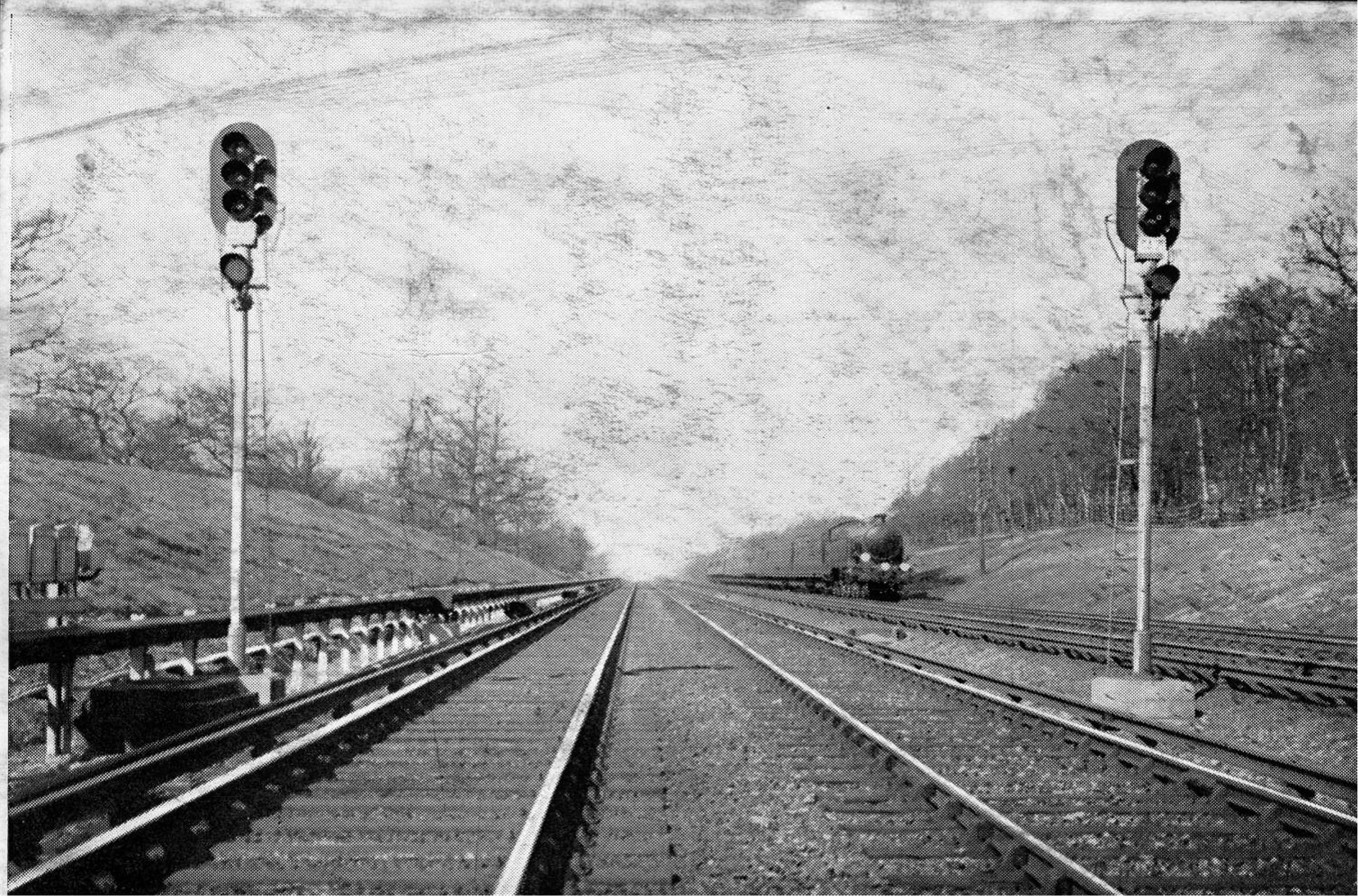
Looking North From Balcombe Tunnel Junction
Brighton Line Signalling
On Whit-Monday, 1933, 107 trains left Brighton in five hours,
carrying 75,000 passengers
The combination of good weather and improved travelling facilities resulted in a great
increase of passenger traffic on the Southern Railway during the Whitsun recess. During the
whole holiday period no less than 129,165 passengers were conveyed to Brighton, mainly by electric trains. This represents an increase of 75 per cent, over last year. On Whit-Sunday the number of people carried to Brighton showed an increase of 174 per cent, over last Whit-Sunday, while on Whit-Monday the increase was 68 per cent.
Reprinted from “ Modern Transport," June 10th, 1933
In the course of the homeward rush from the seaside on Monday evening last, there were
several achievements on the part of the Southern Railway calling for attention. At Brighton a special control tower was installed and brought into use about 4 p.m., its object being to
direct passengers to the various platforms and trains. Between 5 p.m. and 10 p.m. no fewer
than 107 trains left Brighton Central Station, carrying 75,000 passengers. On the average,
therefore, a train departed every three minutes—or slightly less—throughout the five hour
period, and each train carried on an average just over 700 passengers—15,000 an hour. The
great bulk of this traffic was for London or beyond, and had to be carried over the main line,
which has only the one up track as far as Balcombe Tunnel box—19 miles—and in addition
to the trains from Brighton there were those from Worthing and Hove also passing over
almost the whole of this distance. More noteworthy still is the fact that from Keymer Junction to Balcombe Tunnel there were also the Hastings, Bexhill, Eastbourne and Seaford trains to be accommodated by the single up road in addition to those from Brighton and Worthing.
Actually, between Keymer Junction and Haywards Heath the up trains moving over this road were : between 7 and 8 p.m., 13 trains ; between 8 and 9 p.m., 16 ; between 9 and 10 p.m., 18; and between 10 and 11 p.m., 14 trains, the greatest density being one every 3'3 minutes throughout the hour. Only by the employment of automatic colour-light signal- ling, and of very heavy electric trains for the most part, could this traffic be moved within so short a period.
Reprinted from “Railway Gazette," June 9th, 1933
THE WESTING HOUSE BRAKE & SAXBY SIGNAL Co., Ltd.
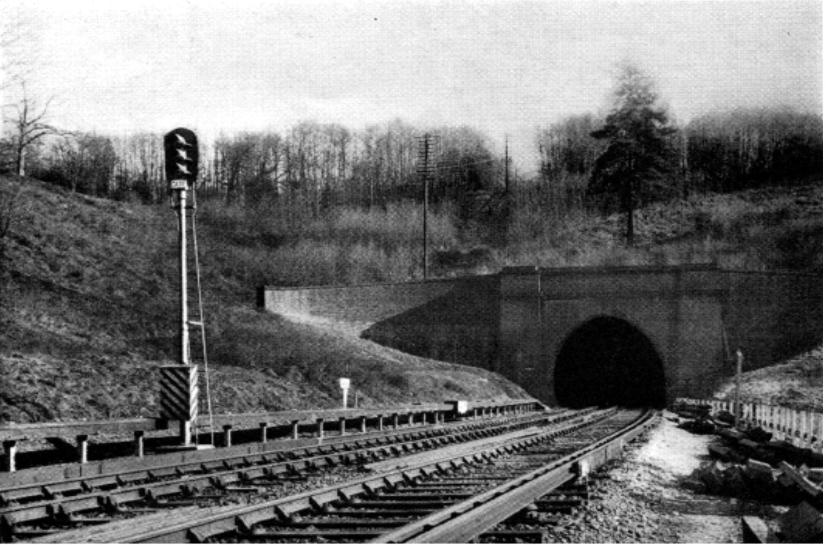
Balcombe Tunnel Northern end
It will be recalled that between the years 1925-1929 the Southern Railway carried out an
extensive programme of signalling conversion in the inner London zone and installed during
that period a complete power signal system, entirely of Westinghouse manufacture, at
Charing Cross, Cannon Street, Borough Market Junction, London Bridge and New Cross,
and on the tracks linking up these stations. This power system covers about 471/2 track miles, carrying an extremely intense suburban traffic in addition to heavy coastal services of both passenger and goods trains.
With the extension of the Electric Service to Brighton and the resultant greatly increased train service, complete reorganisation of the signalling arrangements became a necessity.
The valuable experience gained on the London power signalling showed that a similar system, modified to comply with the characteristics of the Brighton Line, would give the required facilities, and in making the decision to introduce power signalling between Coulsdon and Brighton the Railway Company have added a further 119 track miles of line which are provided throughout with colour light signals and continuous track circuits. As the electrification of the London to Brighton line constitutes the longest section of electrified
railway in Great Britain, so the signalling comprises the greatest length of continuous track
circuiting and complete power signalling on a British main line. Westinghouse apparatus was again selected as possessing that essential reliability necessary to withstand the severe
operating conditions on the 36 miles of route, and advantage was taken of several new
developments and improvements to apparatus, although, in general, the design of apparatus
called for follows closely upon that which has proved equal to all the demands made on it
during the previous four years.
The map and key plan opposite show the line between London and Brighton, and it will be
seen that East Croydon is the Junction for all trains to and from the various London termini.
The power signalling commences at Coulsdon North about 14 miles south from Victoria and
continues through Earlswood Junction to Three Bridges. Three Bridges is the junction for the Horsham and Portsmouth line to the south-west, and for the East Grinstead and Tunbridge Wells line to the east ; in addition, it is of importance owing to the presence of extensive goods sidings, locomotive running sheds, and the main control station for the remote control of all traction sub-stations on the Brighton line. There are four running roads between Earlswood and Balcombe Tunnel, which is about 2f miles south of Three Bridges, the signal cabin situated at the north end of the tunnel having the control of the junction from the four to two roads. The line diverges into four roads again between Copyhold Junction and Hayward's Heath Station, then reverts to double-road track, continuing thus to Preston Park.
A branch line junction at Copyhold is controlled from Hayward's Heath Cabin, about miles
distant, crossovers being provided for the routing of trains for running into the required
platforms at Hayward's Heath. Plans of the track and signal layout at Three Bridges,
Copyhold Junction and Hayward's Heath, will be found at the end of this publication.
A short distance south of Hayward's Heath is Keymer Junction, where the line to Lewes and
Eastbourne diverges. Preston Park is on the outskirts of Brighton, the cabin having control of all traffic to and from London, and it is here that trains running direct between London and Worthing are diverted. Brighton Station lies about 1/2 mile south of Preston Park Station and besides being the terminal station of 10 platforms for London to Brighton traffic, it is also a terminal and junction for the Hastings line to the East and the Worthing and
Portsmouth line to the West (the line joining that from Preston Park at Hove).
There are extensive goods marshalling sidings at Brighton as well as locomotive running
sheds, locomotive and carriage repair shops, large carriage sheds and washing plant for
electric stock.
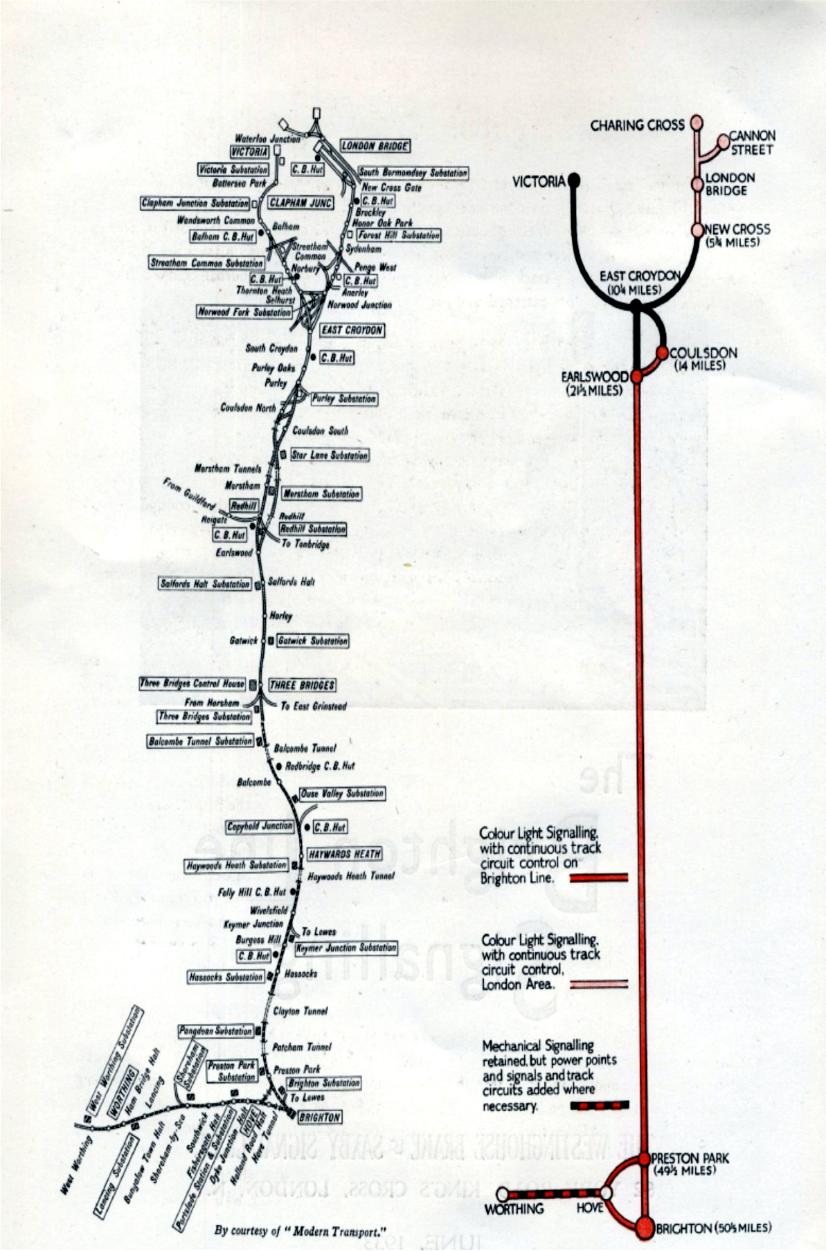
The general signalling scheme employs three-aspect colour light signals throughout for
running signals and two-aspect colour light signals for shunt movements. Exceptions to the
general rule are to be found in cases where it has not been possible to obtain full braking
distance, and here four-aspects have been used to maintain the necessary flow of traffic.
With a single exception all other types of signals, such as call-on and warning signals have been eliminated, thus adding greatly to the uniformity and simplicity of the system without
interfering in any way with expeditious handling of traffic.
The system of control adopted between Coulsdon and Preston Park, a distance of
approximately 31 miles, is electro-mechanical with continuous track circuiting of all running roads, and track circuit fouling protection of junctions and sidings.
At Brighton the system is all-electric, controlled from a new cabin containing a 225-lever
power frame. In the electro-mechanical section certain cabins were selected for retention in
service and all others have been abolished. The selected cabins are those from which the
routing of trains is always being carried out, or where there is at times some shunting of
goods trains, or where special regulation of traffic may occasionally be necessary. Reference
to the diagram on page 21 will make clear the number of cabins totally abolished, those
which are normally switched out, and those, such as Earlswood, Three Bridges, Hayward’s
Heath, Keymer Crossing and Preston Park, which are always in service.
No distinction has been made between the two classes of cabins in the matter of equipment,
except, that at Hayward's Heath and Three Bridges it was found necessary to install new
Style A.2 locking frames of 54 levers and 125 levers respectively. In all cases illuminated
track diagrams of the spot-light type are provided, together with illuminated indicators for
colour light signals and power points. In a number of cases facing points and siding
connections are situated too far from the cabin to be manually operated, and therefore high
speed style M.3 point machines and colour light shunt signals have been installed, controlled
from slightly shortened levers in the mechanical frames. Mechanically-worked dwarf signals
are retained where distances are not too great, as also are semaphore arms on lines joining
the main route. At the entrances to the colour light signalling area the semaphore distant
signal arms are replaced by two-aspect colour light signals, which normally show no light,
but are brought, into operation by the clearing of the stop arm above them.
All points in the track-circuited area, or which lead on to the running roads, are electrically
detected, and all point levers are fitted with Style D lever locks and circuit controllers to
track-lock the lever in the Normal and Reverse positions ; facing point bolt levers are locked
in the Reverse position only. Many signal levers have electric lever locks of the Style E
pattern, to lock the lever in the Normal Indication position for back locking.
It has been possible, in the majority of cases, to house most of the apparatus in the lower
compartment of the signal cabin.
The apparatus to be accommodated consists of single element Style H.2 A.C. line relays for
signal control, double element Style G.2 A.C. track relays, and Style G.2 three-position vane
point detector relays, together with the necessary transformers, rectifiers for the point
machines, and, of course, the requisite fuses, power supply switches, etc. All track feed sets
are located outside the cabin in separate feed cases, and in a number of instances, the track
relays are also housed outside the cabin.
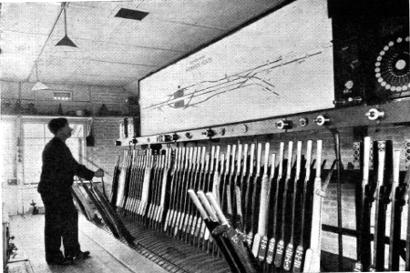
Haywards Heath Signal Cabin
The general signalling scheme employs three-aspect colour light signals throughout for running signals and two-aspect colour light signals for shunt movements.
Exceptions to the general rule are to be found in cases where it has not been possible to obtain full braking distance, and here four-aspects have been used to maintain the necessary flow of traffic. With a single exception all other types of signals, such as call-on and warning signals have been eliminated, thus adding greatly to the uniformity and simplicity of the system without interfering in any way with expeditious handling of traffic.

Haywards Heath Signal Cabin
The general signalling scheme employs three-aspect colour light signals throughout for running signals and two-aspect colour light signals for shunt movements.
Exceptions to the general rule are to be found in cases where it has not been possible to obtain full braking distance, and here four-aspects have been used to maintain the necessary flow of traffic. With a single exception all other types of signals, such as call-on and warning signals have been eliminated, thus adding greatly to the uniformity and simplicity of the system without interfering in any way with expeditious handling of traffic.
The system of control adopted between Coulsdon and Preston Park, a distance of approximately 31 miles, is electro-mechanical with continuous track circuiting of all running roads, and track circuit fouling protection of junctions and sidings.
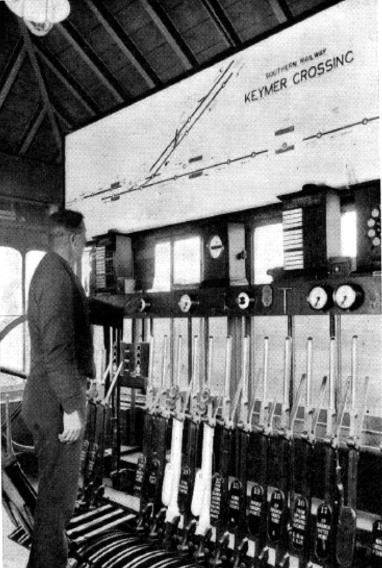
Keymer Junction Signal Cabin
At Brighton the system is all-electric, controlled from a new cabin containing a 225-lever power frame. In the electro-mechanical section certain cabins where selected for retention in service and all others have been abolished. The selected cabins are those from which the routing of trains is always being carried out, or where there is at times some shunting of goods trains, or where special regulation of traffic may occasionally be necessary. A number of cabins totally abolished, and those which are normally switched out, and those, such as Earlswood, Three Bridges, Hayward's Heath, Keymer Crossing and Preston Park, which are always in service.
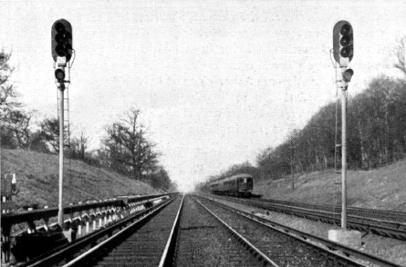
No distinction has been made between the two classes of cabins in the matter of equipment, except, that at Hayward’s Heath and Three Bridges it was found necessary to install new Style A.2 locking frames of 54 levers and 125 levers respectively. In all cases illuminated track diagrams of the spot-light type are provided, together with illuminated indicators for colour light signals and power points. In a number of cases facing points and siding connections are situated too far from the cabin to be manually operated, and therefore high
speed style M.3 point machines and colour light shunt signals have been installed, controlled from slightly shortened levers in the mechanical frames. Mechanically-worked dwarf signals are retained where distances are not too great, as also are semaphore arms on lines joining the main route. At the entrances to the colour light signalling area the semaphore distant signal arms are replaced by two-aspect colour light signals, which normally show no light,
but are brought, into operation by the clearing of the stop arm above them.
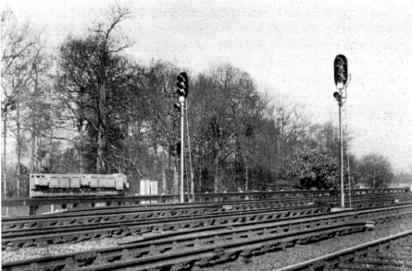
All points in the track-circuited area, or which lead on to the running roads, are
electrically detected, and all point levers are fitted with Style D lever locks and circuit
controllers to track-lock the lever in the Normal and Reverse positions ; facing point bolt levers are locked in the Reverse position only.
Many signal levers have electric lever locks of the Style E pattern, to lock the lever in the Normal Indication position for back-locking.
It has been possible, in the majority of cases, to house most of the apparatus in the lower compartment of the signal cabin.
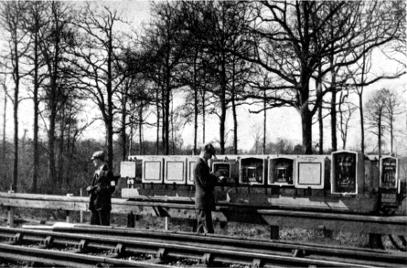
The apparatus to be accommodated consists of single element Style H.2 A.C. line relays for signal control, double element Style G.2 A.C. track relays, and Style G.2 three-position vane
point detector relays, together with the necessary transformers, rectifiers for the point machines, and, of course, the requisite fuses, power supply switches, etc. All track feed
sets are located outside the cabin in separate feed cases, and in a number of instances, the track relays are also housed outside the cabin.
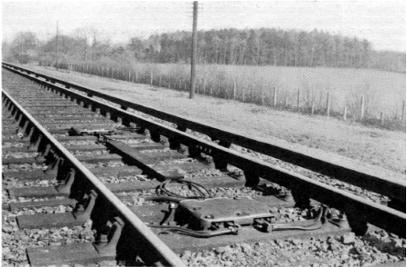
An interesting feature of the point machine control at the electro-mechanical cabins Is the
provision of special arrangements for hand-operating the machines. The crank-handles kept
at any cabin are constructed in such a way that they are not interchangeable among the
machines, but only fit their own particular point machine or group of point machines. The
handles are kept normally in separate circuit controllers (see illustration opposite) whose
contacts break the point control and detection circuits for the machine concerned, when the
crank-handle is removed. Padlocks are placed on each controller to prevent unauthorised
removal, the key being retained in the cabin behind a glass-fronted box for use in emergency, and a duplicate is in the possession of the lineman.
The object of these precautions is to eliminate any possibility of confusion leading to
illegitimate hand-operation of a machine in an emergency or during maintenance duties.
The apparatus outside the cabins, is uniform in design throughout the line. Track circuits at
crossings and junctions are single-rail, while those for the remainder of the line are double
rail. Owing to the third-rail system of traction, impedance bonds are employed on all double-rail track circuits, and in some cases additional impedance bonds are placed intermediately for cross-bonding purposes on the traction system. The average length of a double-rail track circuit is about 1,500 yards.
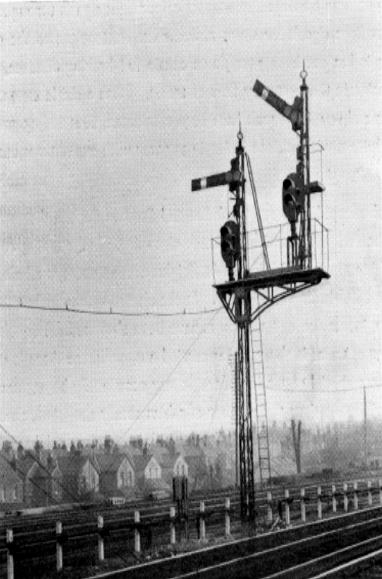
Upper-quadrant Semaphore signals, with 2
aspect Colour-light Distant Signals -
Earlswood Junction
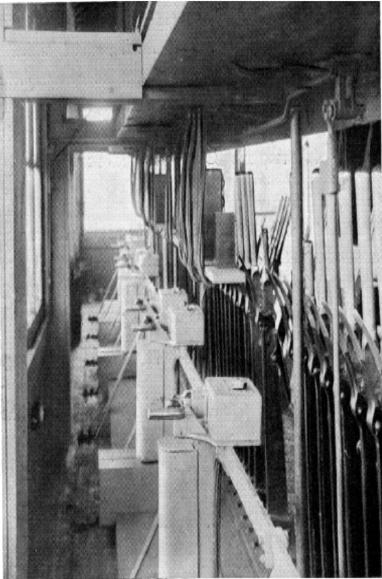
Points Machine Crank Handles and
Interlocked Circuit
Controllers Earlswood Junction Cabin
The running signals are of the standard Westinghouse long-range pattern, having double
filament 12-volt, 25-watt, 3-pin lamps ; in addition to the auxiliary light deflecting unit in
each aspect, separate sidelights have been fitted on all signals on the installation and have
proved of great benefit to motormen of electric trains, which can draw up very close to a
signal. All automatic signals between cabins are distinguished by an " A " light mounted just
below the main signal, the " A " being illuminated only when the red aspect is showing above it. Typical automatic signal locations are illustrated on this page and page 9, those on this page showing the apparatus cases which contain the signal control relays, track feed sets, and track relays. Signals which are sometimes controlled from a cabin and at other times work as " automatics " also carry " A " lights, such " A " lights being cut out when the signal is " controlled." Exceptions to this arrangement are the fully automatic signals located at entrances to tunnels ; such signals are not fitted with " A " lights, as the " one minute rule “ does not apply at tunnels. The auto-signal at the entrance to Balcombe Tunnel, illustrated on the frontispiece, is an instance of this. If a train is stopped by a red aspect at one of these
signals (also at any controlled signal) the driver or motorman must communicate with the
nearest signal cabin by a telephone contained in a black and white striped box fixed to the
signal post or nearby.
Most of the signals are mounted on pipe posts, although several bracket arrangements are to
be found. The illustration of Copyhold up home signals below is an instance of a very
compact structure built in our shops. Shunt signals, one of which is illustrated at the bottom
of this page, are of the globe type similar to those used at London Bridge, and display the
usual Red and Green aspects with the exception of a few siding signals which have Yellow
and Green aspects.
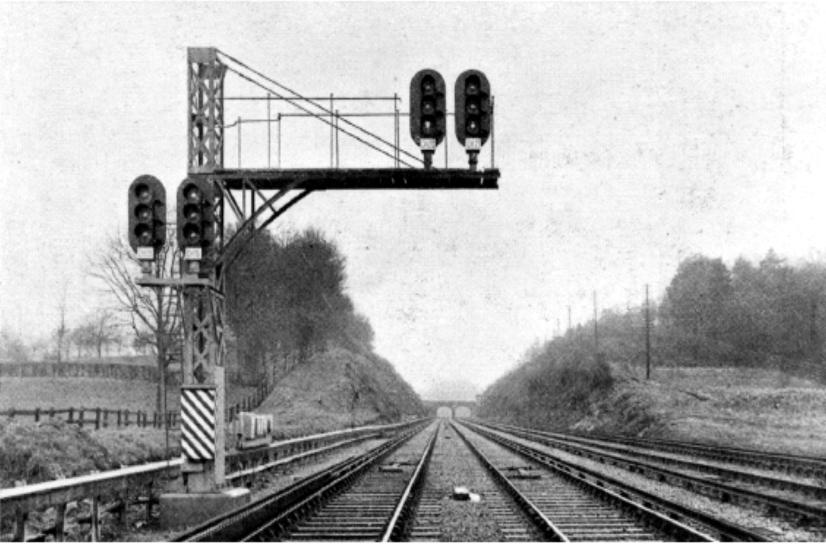
Copyhold Junction
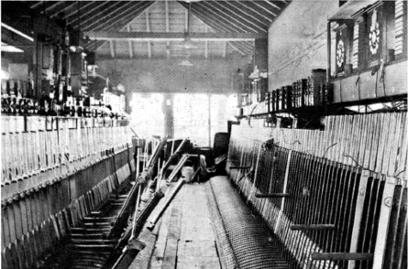
Three Bridges Cabin during installation of
the new Locking Frame
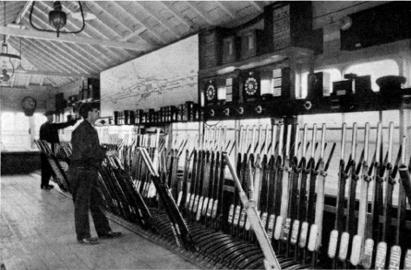
Three Bridges Cabin, as it now appears
Before going on to describe the apparatus at Brighton, special mention must be made of a
notable signal engineering feat carried out at Three Bridges. Originally there were three
cabins, but under the new arrangement one cabin was to handle the whole of the work, the
Central Cabin having been selected for the purpose. This cabin contained an old Saxby
rocker frame of 94 levers which, it was found, could not be converted satisfactorily ; it was
decided therefore to install a new 125-lever Westinghouse Style A.2 frame, which was
actually erected in the cabin opposite the old frame as shown above.
On the night of bringing into service of the new signalling, the new frame was connected up
and the old one disconnected and eventually taken out, without any interference to traffic.
The completed interior of the cabin as it now appears is illustrated below.
Referring now to the signalling at Brighton itself, it has already been mentioned that a new
225-Iever power frame has been provided. The new cabin takes the place of six old cabins
and the 225 power levers do the work of 562 mechanical levers.
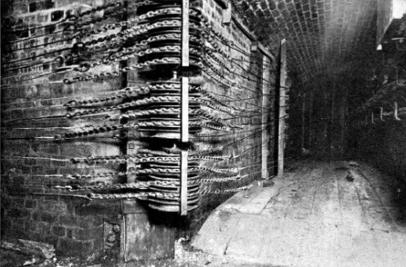
Subway under the lines at Brighton Station
showing old mechanical connections now
used for signal cables.
An exterior view of the cabin is given on page 14, the windows shown being those of the main operating room, directly behind which is the relay room and linemen's mess room.
Access to the cabin is by a former signal bridge now devoid of signal dolls and, in addition to being a walkway, serves to carry many of the signal cables. It may here be mentioned that, when the previous remodelling of Brighton Station in 1881, was carried out, a special subway was constructed under the running lines to accommodate point rods and signal wires.
This subway, shown above, which has been extended, proved of considerable value, as it has
been employed as an additional means of conducting cables from the down side across to the Worthing Branch. A general view of the interior of the cabin is given on pages 12 and 13, and clearly shows the power frame and illuminated diagrams.
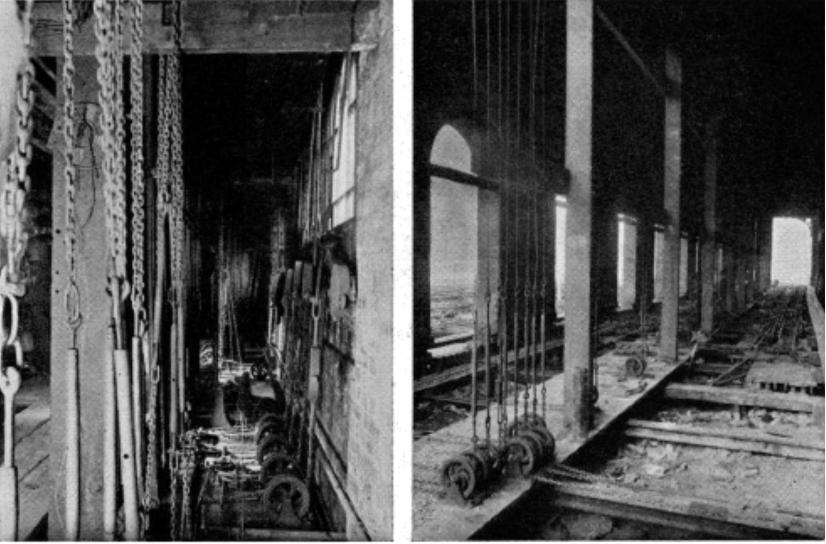
Mechanical Point and Signal Connections under old cabins at Brighton, now removed
The power frame is a Westinghouse Style all-electric with no mechanical lever interlocking.
Full advantage has been taken of the flexibility of the all-electric frame by dividing the levers into three sections, the two end sections being placed at an angle to the middle section. This arrangement saves a considerable amount of cabin space and at the same time increases very noticeably, the ease of co- operation between signalmen, and observation of the diagrams.
Electric lever interlocking is provided on all levers and is laid out to give the same effect as
mechanical lever interlocking.
All signal aspects are repeated behind the levers together with route-indicator indications,
point indications, and “ground frame free" indications. Signal levers are provided with
normal indication locks, but front (normal) locks are not fitted. Point levers have normal and
reverse track locks, and if the track circuits are unoccupied a point lever can be pulled
directly from normal to reverse, or vice versa, there being no point indication locking. Since
the signal levers have no front locks and the point levers have no indication locks, it would be possible to reverse a signal lever before the points had fully responded to a previous
movement of a point lever. The signal would not, however, show a " proceed " aspect in these circumstances, unless the signal lever was first put back and again pulled. In order, therefore, to assist the signalman in this respect a special indication is provided behind each signal lever consisting of an illuminated " F " which appears only when the various points in the desired route have completely responded to the movement of the lever and the requisite track circuits are clear.
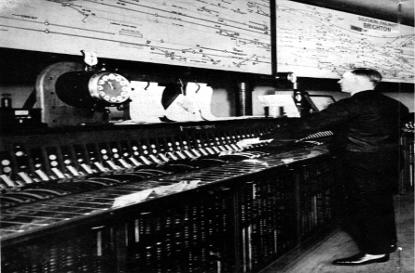
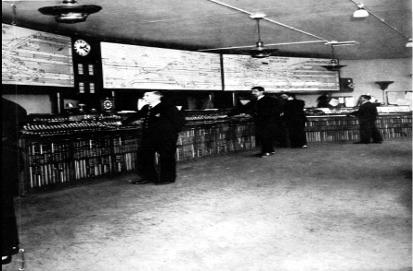
Interior of the Brighton Cabin with 225 levers.
At the time the photographs was taken two additional men were being trained. The normal
staff employed on this locking farm is :-
For each of the two day shifts 3 signalmen, and for the night shift 2 signalmen,
The lever interlocking circuits are controlled through contact shafts on the front of the frame, while operation and selection circuits have their contacts fitted to shafts on the back of the frame. Both sets of contacts are of the high speed air break type, and can be observed, for maintenance purposes, through glass panels in the sheet steel casing surrounding each
section of the power frame.
The Style M.2 Illuminated Diagrams have been specially designed for this cabin. The
background of the diagrams is of pale green shade to lessen the possibility of eyestrain from
constant observation, and the particular colouring of the track circuits has been chosen as
being the most easily followed. Two complete diagrams are provided and, as will be noted
from the illustration, are fixed above the frames and at an angle of approximately half the
displacement of the power frame sections.
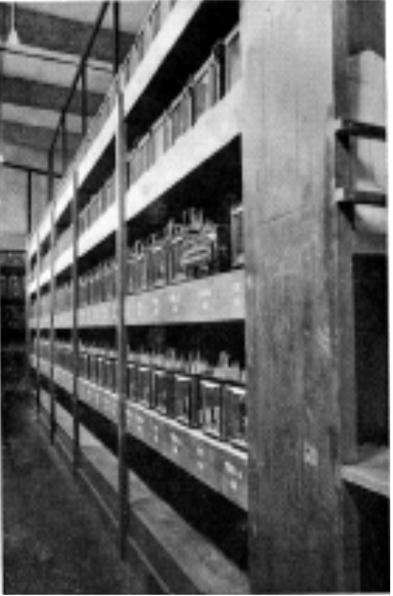
Relay Room
Brighton
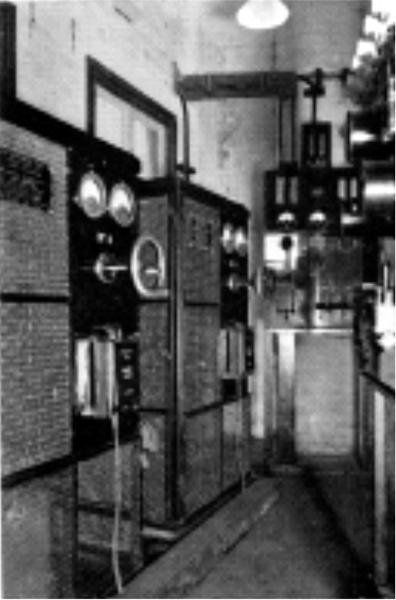
Metal Rectifier Charging Plant for Point-
Machine Batteries
The cables from the power frame and diagrams, together with all cables from the track, are
led into a cable compartment below the power frame floor and from there are taken through
suitable ducts to the adjacent relay room, a part of which is shown opposite. The main
transformers, with their switches, fuses and power distribution board, are also housed in the
relay room. The cables from outside the cabin are multicore and are terminated in the relay
room on porcelain terminal blocks, from which flame-proof wires connect to the relays.
A.C. relays are used for all purposes. A new type of relay has been used for point indication,
viz., the Style Q. three-position vane relay, with a complement of 8N and 8R contacts, which enables a considerable economy to be obtained by the elimination of many repeater relays and relay cabinet space. Previous Southern Railway practice has been continued in the method of wiring, and in placing fuses and indication resistances close to the relays to which they refer.
The accumulator battery is housed below the relay room on track level, with the Westinghouse metal rectifier trickle charging plant and switch gear in an adjacent
compartment (see opposite page). In addition to supplying the point machine current, the
battery is tapped at 10-volts to supply the power frame interlocking magnets in an emergency.
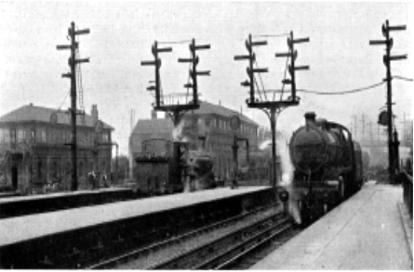
Brighton Station Starting Signals etc.
before alterations
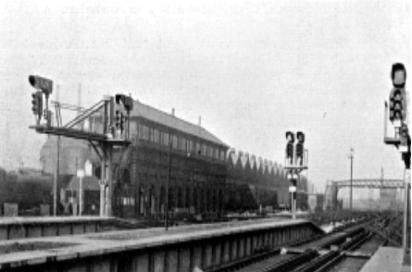
Brighton Station Starting Signals etc.
after alterations
The running signals are identical with those between Brighton and Coulsdon, and are
supplemented in a number of cases by optical route indicators. The platform intermediate
signals are not worked from levers, but repeat the starting signals. The route indicator
associated with each platform intermediate signal shows the letter " M " or " S " according to whether the main signal or shunt signal on the starting signal post is showing a " proceed aspect."
A number of different signal arrangements are illustrated. The two pictures above, taken from a similar viewpoint, afford a clear comparison between the old mechanical and new colour light signalling.
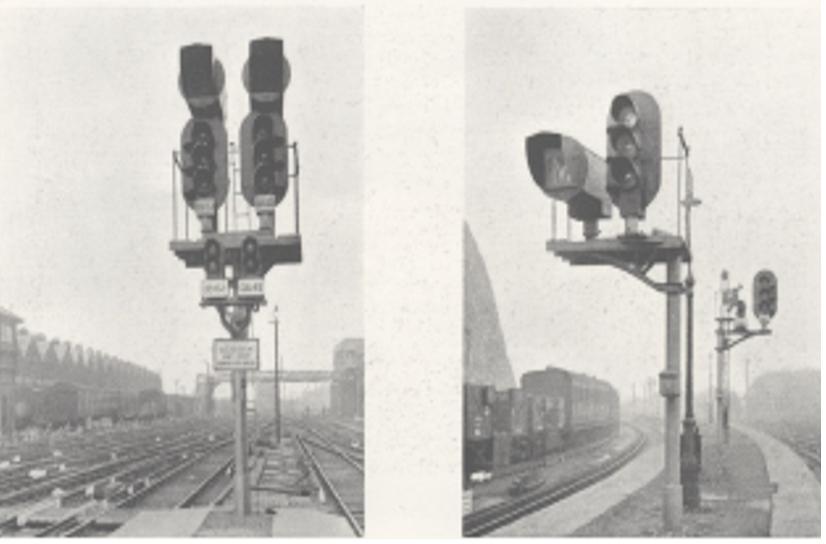
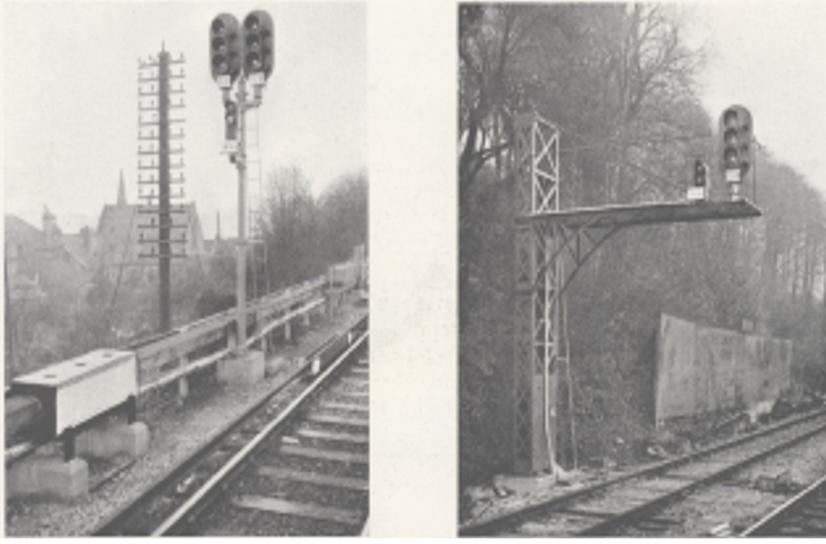
The running signals are identical with those
between Brighton and Coulsdon, and are
supplemented in a number of cases by
optical route indicators. The platform
intermediate signals are not worked from
levers, but repeat the starting signals. The
route indicator associated with each
platform intermediate signal shows the
letter " M " or " S " according to whether
the main signal or shunt signal on the
starting signal post is showing a " proceed “
aspect.
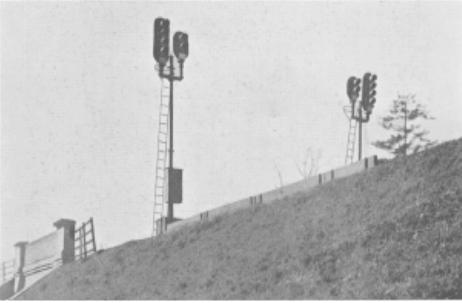
A number of different signal arrangements are illustrated. The two pictures, taken from a
similar viewpoint, afford a clear comparison between the old mechanical and new colour
light signalling.
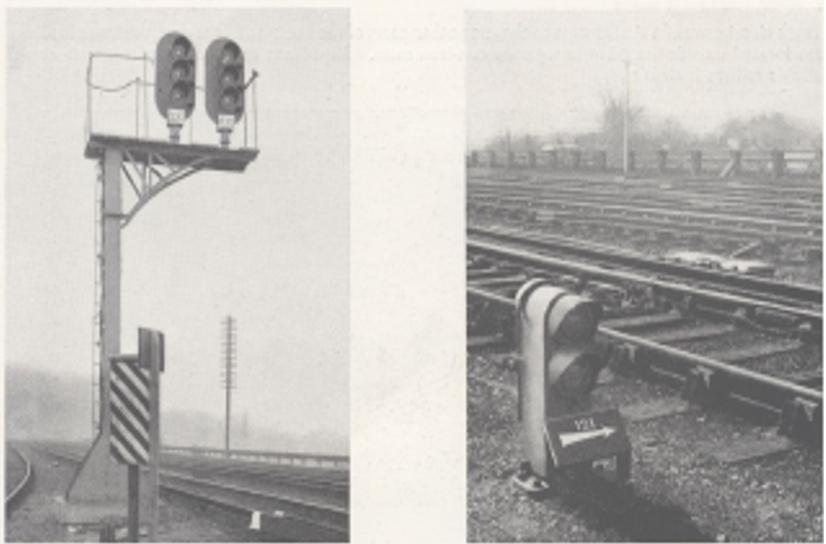
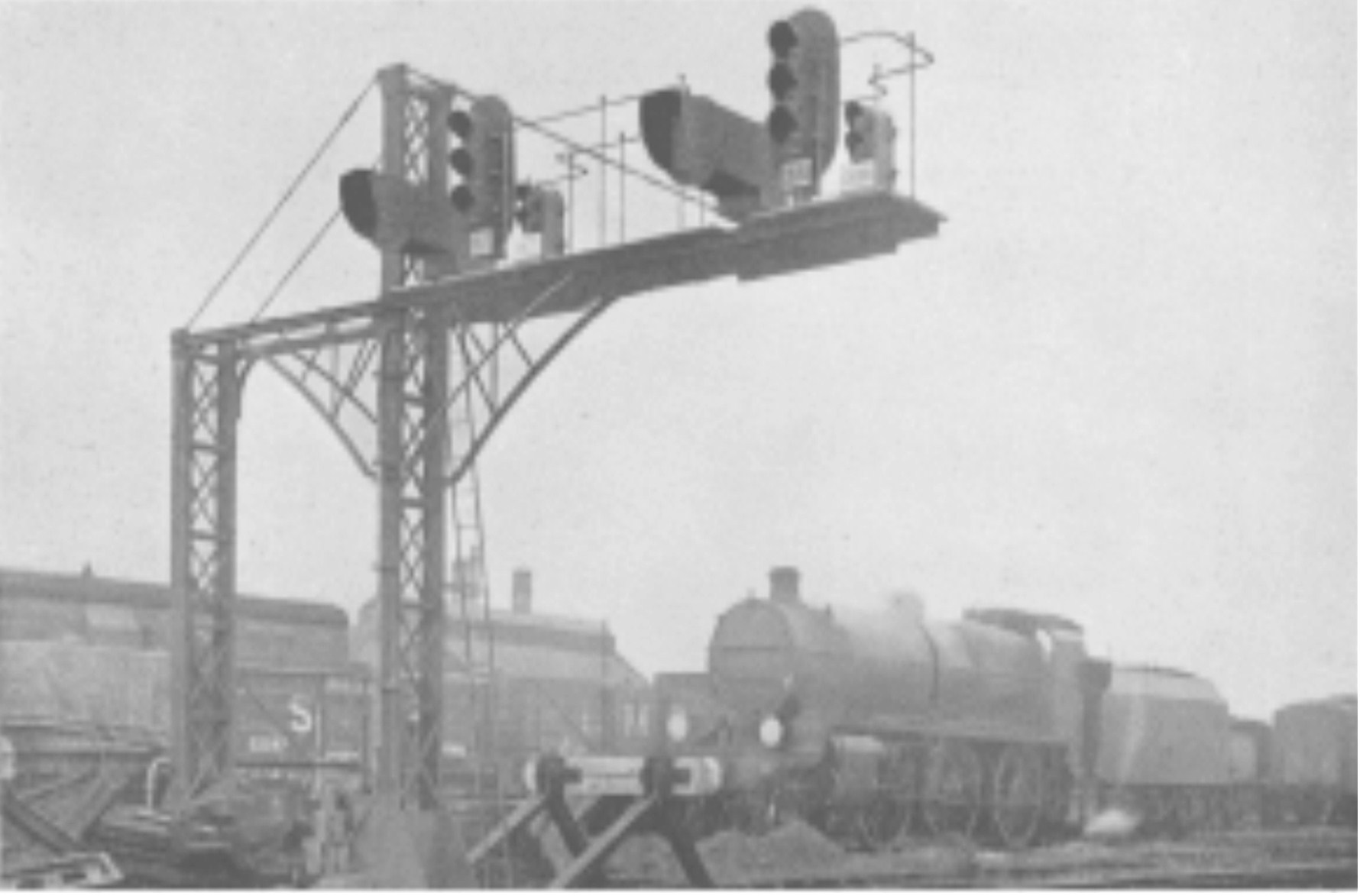
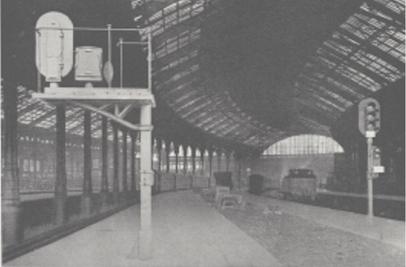
Style M.3 D.C. point machines are employed on all power operated points. The single switch and slip layouts are of the usual design and do not require any special mention. The
illustrations below show two power point layouts which are of considerable interest. The
upper photograph shows a " three-throw " layout operated from two separate machines ;
while the lower one is of a movable diamond layout of which there are two sets in the yard,
and which are unusual in that the diamond includes a slip connection.
Track circuits are of a similar type to those on other parts of the line; and here also, the track
feed sets are located outside the cabin in separate cast-iron cases. Impedance bonds are used
when there are double rail track circuits.
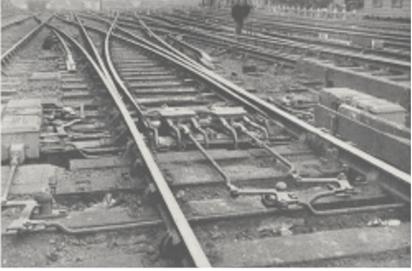
Three-throw Point Layout operated
by two Style Point Machines
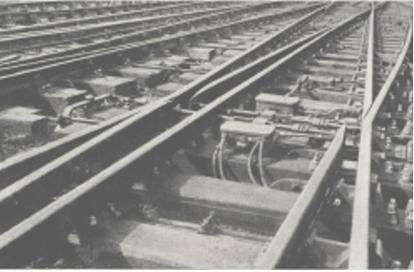
Movable Diamond Layout
A diagram of the various cabins abolished
is shown alongside.
From this it will be noted that altogether 24 cabins involving 1,093 levers, have been totally abolished, while 9 cabins having 324 levers are normally switched out. This leaves only 8 cabins in regular service to handle the exceptionally heavy traffic, not only to Brighton, but to Worthing, Eastbourne, Portsmouth and several other branch lines.
The whole of the work (with the exception
of the power frame at Brighton, which was
erected by this Company) was installed by
the Southern Railway and reflects the very
greatest credit upon the organization and
skill of the Signalling Staff, and which was further demonstrated during the various openings.
The work was completed in four stages and the new signalling brought into service without any interruptions to traffic.
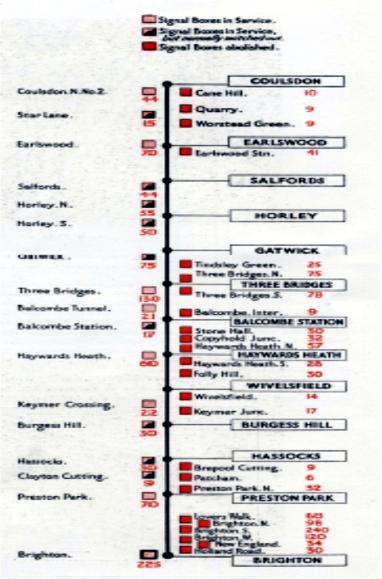
The first section, that between Coulsdon and Balcombe, was brought into use on Sunday,
June 5th, 1932, in six hours ; the next, Balcombe to Copyhold Junction, on Monday, October 3rd, in fifteen minutes for each line ; then followed the section Hayward's Heath to Preston Park, inclusive, on Sunday, October 6th, in one hour ; and finally, Brighton Station on Sunday, October 16th, in approximately 6 1/2hours.
BRIGHTON’S SIGNAL CABINS
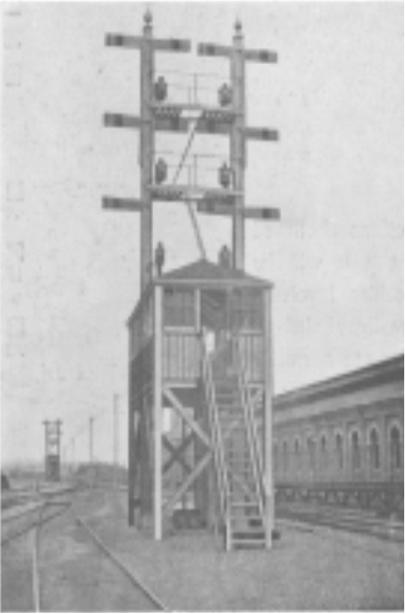
Brighton North cabin as first installed in
1871
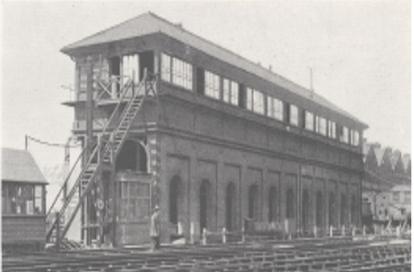
Brighton South Cabin Installed 1881
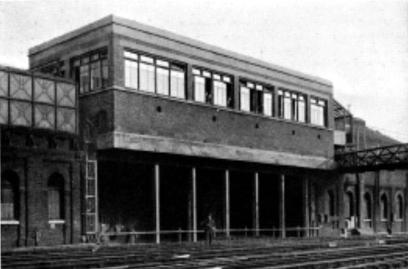
The exterior of Brighton Cabin 1933
As a concluding note to this description of
the latest signalling installation at Brighton
some brief reference to the earlier
installations may be of interest, as they
constitute an outstanding and unique record
of the manufacture of Railway Signalling
Appliances.
The first installation was put into service
about the year 1871, the materials being
supplied and installed by Messrs. Saxby &
Farmer. A general view of the layout is
shown in the picture above. Ten years later
the station was considerably extended
and remodelled, and again Messrs. Saxby & Farmer were entrusted with the supply and installation of the necessary apparatus. The illustration below is a diagram of the layout of tracks and signalling at that time, while views of the largest of the three cabins are shown on the page opposite. For the purpose of comparison a view of the interior of the new cabin is also shown opposite.
Thus in a period extending over 60 years,
during which three installations have been
provided, the same firm, under the title first
of Saxby & Farmer, and subsequently The
Westinghouse Brake and Saxby Signal
Company, Ltd., have supplied the necessary
materials.

240 Lever Mechanical Frame in Brighton
South Cabin. Note Mechanical Locking
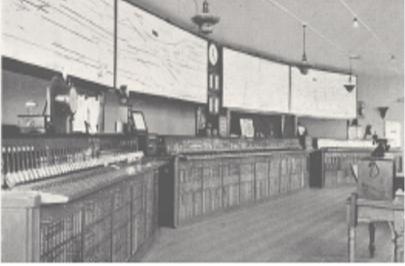
Interior of the new Cabin showing
225-Lever Point Frame
with all electric interlocking